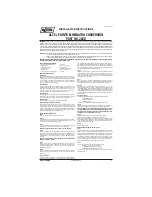
P 120
VOLVO
100 953
Fig.
44.
Fitting headlining fabric in corner
8-1 8
Fig. 45.
Adjusting teazel strip
Fig. 46.
Window moulding
A. Indentations
B.
Rubber strip
C. Sealing compound
D.
Rubber strip
VOLVO
1 00 952
TRIM MOULDINGS
Waist mouldings
The waist mouldings, and the upper trim moulding
for the door on the
P 120
2-door model, are
attached with clips. The mouldings are removed
with the help of a putty knife with which they are
carefully unfastened. Before fitting the mouldings,
the holes should be filled with sealing compound.
Window mouldings
REMOVING
Wind down the window. Apply masking tape or
similar as shown in Fig.
47
in order to protect the
paintwork. From inside, place a screwdriver under
the rear edge of the moulding in line with the in-
dentations which secure it, see Figs. 46 and 48. Prise
carefully upwards with the screwdriver and at the
same time pull outwards and downwards with the
hand so that the rear retaining spring can be hooked
off with SVO
2297,
see Fig.
49.
Carefully pull out
the moulding backwards.
FITTING
Stick the profile rubber strips at both ends of the
window moulding and apply sealing compound
along the inner section of the moulding, see Fig.46.
Place the retaining springs in position and apply
sealing compound as shown in Fig. 50. Push the
window moulding in position under the rubber strip
of the ventilation window as shown in Fig. 51. Lift
the inner ridge of the moulding over the metal
edge of the door and press down so that the inden-
tations, Fig. 46, locate in the holes in the sheet
metal edge. Press up the retaining springs with
SVO 2297,
see Fig. 52.
Moulding for rear side window,
Station Wagon
When fitting the clips for the moulding, one of the
legs is inserted in the recess in the moulding, the
clip pressed together and the other leg inserted.
Apply sealing compound over the fastenings and
press the moulding into position.












































